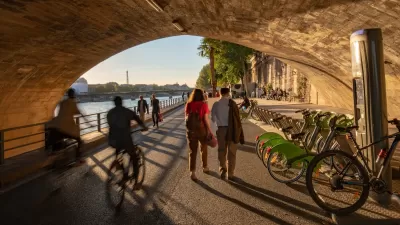I just got back from my first trip to Europe, where the cities are a lot older and a lot different than they are here in the New World. I made many observations on my brief trip, which included Paris and Barcelona, and I'm sure those will bubble up in blog posts in the near future. However, I won't waste anyone's time remarking about how great European cities are. We've all heard it before, and while it may be right, the point has been made. Like, really made. So, yes, the narrow streets are nice to walk on, the bike sharing system in Paris is awesome, and the architecture is impressive. But one piece of these cities that hasn't receioved enough praise is their garbage cans.
I just got back from my first trip to Europe, where the cities are a lot older and a lot different than they are here in the New World. I made many observations on my brief trip, which included Paris and Barcelona, and I'm sure those will bubble up in blog posts in the near future. However, I won't waste anyone's time remarking about how great European cities are. We've all heard it before, and while it may be right, the point has been made. Like, really made.
So, yes, the narrow streets are nice to walk on, the bike sharing system in Paris is awesome, and the architecture is impressive. But one piece of these cities that hasn't receioved enough praise is their garbage cans.
Specifically, I'm talking about Paris here, and more specifically, we can't even call them garbage cans. As you can see in the picture below (yes, I take pictures of garbage cans on vacation), these garbage "cans" are not much more than posts, hoops and plastic bags.

Now that's simple infrastructure. A post, a hoop and a bag. It's got to cost next to nothing to make one of these things – a lot less than a bulky concrete block or metal can like you see in many cities. But it gets the job done. Additionally, it makes trash collection really easy. A simple elastic bungee band holds the bag to the hoop, so all the trash collectors have to do is lift the band, take the bag, and add another. There's no reaching into a dark nasty can, no picking up and dumping out, and no gross garbage water pooling at the bottom for months or more.

A local friend tells me the reason behind this system is less about efficiency than safety. The simple post-hoop-bag replaced the traditional concrete can holder after miscreants had caused a bunch of damage in 1995 hiding bombs inside garbage cans. To reduce that threat, the cans were replaced with clear plastic bags. Now not much can hide in the new garbage cans of Paris.
An additional benefit that may not be relevant in Paris but which would certainly be a big improvement in American cities is that, in the same way that police can see bombs in a clear plastic bag, people who collect bottles and cans don't have to reach into a can (or turn it over) to see if there are any recyclables inside. It makes life easier for those who make their living this way, and cuts down on the mess that results from those who do so inconsiderately.
But garbage on the street isn't really a problem in Paris, or at least it wasn't in the places I went. The reason, I'm guessing, has a lot to do with the sheer amount of places to put garbage. The post-hoop-bag is ubiquitous in the city. It's hard to turn your head without seeing one. Or more.

This is a European model American cities should follow. Cities need garbage collection infrastructure, so it might as well be cheap. If it can also be highly dispersed, maintained efficiently and used effectively by the public, that's even better.
And if it does things really well, it might even end up in a photo album from some nerd's vacation.

Alabama: Trump Terminates Settlements for Black Communities Harmed By Raw Sewage
Trump deemed the landmark civil rights agreement “illegal DEI and environmental justice policy.”

Planetizen Federal Action Tracker
A weekly monitor of how Trump’s orders and actions are impacting planners and planning in America.

The 120 Year Old Tiny Home Villages That Sheltered San Francisco’s Earthquake Refugees
More than a century ago, San Francisco mobilized to house thousands of residents displaced by the 1906 earthquake. Could their strategy offer a model for the present?

Opinion: California’s SB 79 Would Improve Housing Affordability and Transit Access
A proposed bill would legalize transit-oriented development statewide.

Record Temperatures Prompt Push for Environmental Justice Bills
Nevada legislators are proposing laws that would mandate heat mitigation measures to protect residents from the impacts of extreme heat.

Downtown Pittsburgh Set to Gain 1,300 New Housing Units
Pittsburgh’s office buildings, many of which date back to the early 20th century, are prime candidates for conversion to housing.
Urban Design for Planners 1: Software Tools
This six-course series explores essential urban design concepts using open source software and equips planners with the tools they need to participate fully in the urban design process.
Planning for Universal Design
Learn the tools for implementing Universal Design in planning regulations.
Clanton & Associates, Inc.
Jessamine County Fiscal Court
Institute for Housing and Urban Development Studies (IHS)
City of Grandview
Harvard GSD Executive Education
Toledo-Lucas County Plan Commissions
Salt Lake City
NYU Wagner Graduate School of Public Service





























